Report: Comparing Construction Procurement Methods for WSU Students
VerifiedAdded on 2023/06/03
|11
|2803
|386
Report
AI Summary
This report provides a comparative analysis of three construction procurement methods: traditional, Design and Build, and construction management. It explores the advantages and disadvantages of each method for different stakeholders, including clients, consultants, builders, subcontractors, and end-users. The report details the characteristics of each procurement system, compares them across control, costs, risk, and time, and offers recommendations on the types of projects suited to each method. It concludes that the choice of procurement method depends on the client's needs, considering factors like quality, tendering costs, and project completion time. The report highlights the traditional method's emphasis on quality and client control, the Design and Build method's speed and cost certainty, and the construction management method's flexibility and contractor management capabilities. Desklib offers this and many other solved assignments to help students with their studies.
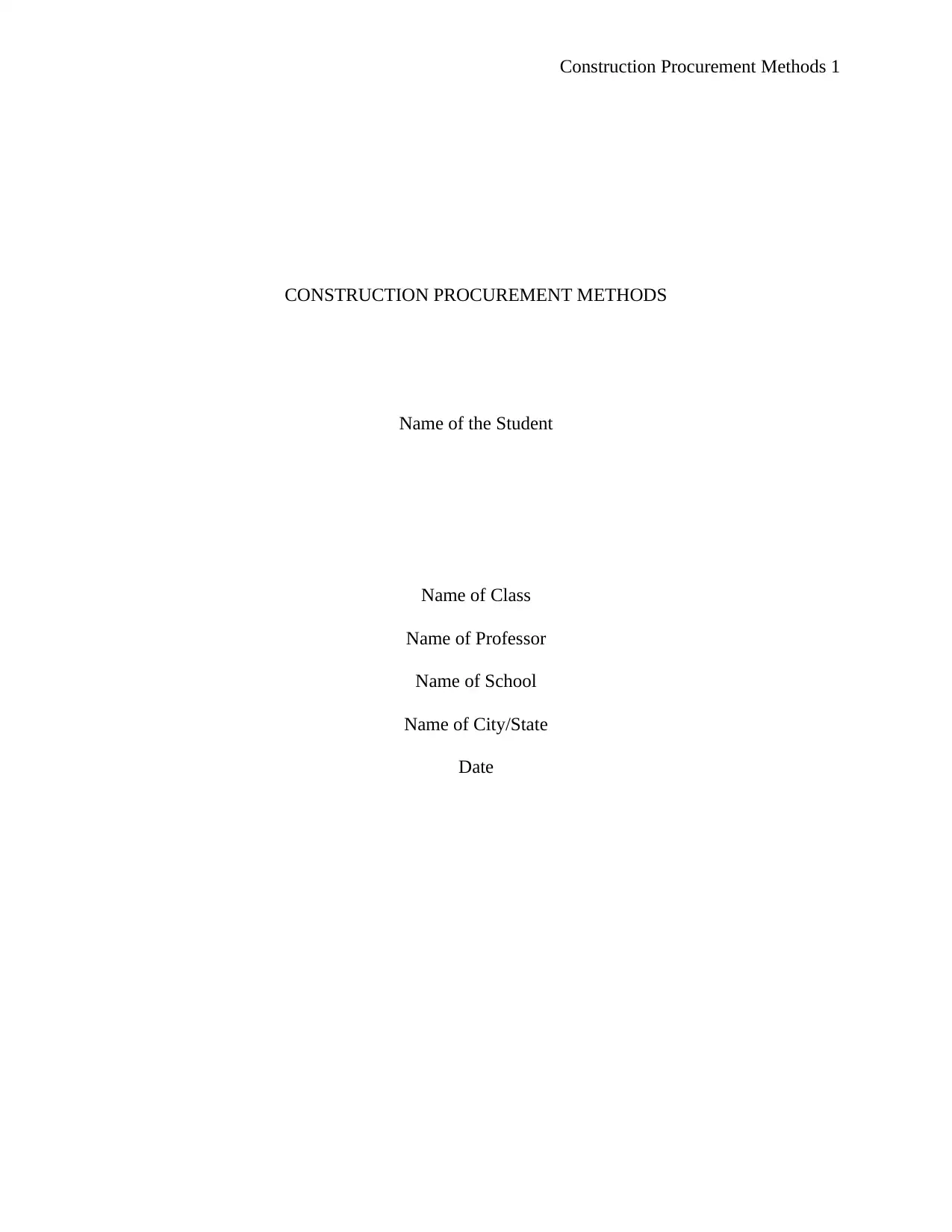
Construction Procurement Methods 1
CONSTRUCTION PROCUREMENT METHODS
Name of the Student
Name of Class
Name of Professor
Name of School
Name of City/State
Date
CONSTRUCTION PROCUREMENT METHODS
Name of the Student
Name of Class
Name of Professor
Name of School
Name of City/State
Date
Paraphrase This Document
Need a fresh take? Get an instant paraphrase of this document with our AI Paraphraser
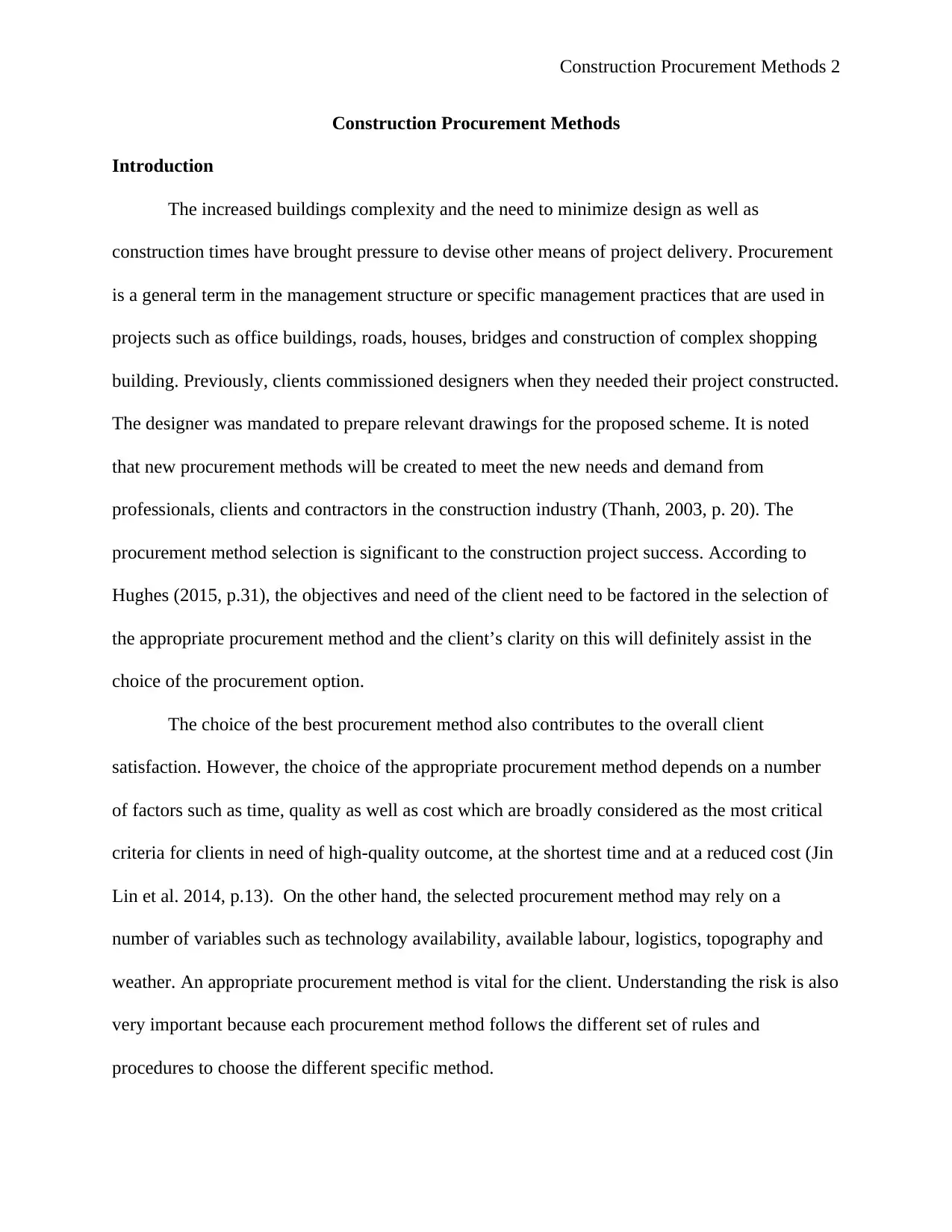
Construction Procurement Methods 2
Construction Procurement Methods
Introduction
The increased buildings complexity and the need to minimize design as well as
construction times have brought pressure to devise other means of project delivery. Procurement
is a general term in the management structure or specific management practices that are used in
projects such as office buildings, roads, houses, bridges and construction of complex shopping
building. Previously, clients commissioned designers when they needed their project constructed.
The designer was mandated to prepare relevant drawings for the proposed scheme. It is noted
that new procurement methods will be created to meet the new needs and demand from
professionals, clients and contractors in the construction industry (Thanh, 2003, p. 20). The
procurement method selection is significant to the construction project success. According to
Hughes (2015, p.31), the objectives and need of the client need to be factored in the selection of
the appropriate procurement method and the client’s clarity on this will definitely assist in the
choice of the procurement option.
The choice of the best procurement method also contributes to the overall client
satisfaction. However, the choice of the appropriate procurement method depends on a number
of factors such as time, quality as well as cost which are broadly considered as the most critical
criteria for clients in need of high-quality outcome, at the shortest time and at a reduced cost (Jin
Lin et al. 2014, p.13). On the other hand, the selected procurement method may rely on a
number of variables such as technology availability, available labour, logistics, topography and
weather. An appropriate procurement method is vital for the client. Understanding the risk is also
very important because each procurement method follows the different set of rules and
procedures to choose the different specific method.
Construction Procurement Methods
Introduction
The increased buildings complexity and the need to minimize design as well as
construction times have brought pressure to devise other means of project delivery. Procurement
is a general term in the management structure or specific management practices that are used in
projects such as office buildings, roads, houses, bridges and construction of complex shopping
building. Previously, clients commissioned designers when they needed their project constructed.
The designer was mandated to prepare relevant drawings for the proposed scheme. It is noted
that new procurement methods will be created to meet the new needs and demand from
professionals, clients and contractors in the construction industry (Thanh, 2003, p. 20). The
procurement method selection is significant to the construction project success. According to
Hughes (2015, p.31), the objectives and need of the client need to be factored in the selection of
the appropriate procurement method and the client’s clarity on this will definitely assist in the
choice of the procurement option.
The choice of the best procurement method also contributes to the overall client
satisfaction. However, the choice of the appropriate procurement method depends on a number
of factors such as time, quality as well as cost which are broadly considered as the most critical
criteria for clients in need of high-quality outcome, at the shortest time and at a reduced cost (Jin
Lin et al. 2014, p.13). On the other hand, the selected procurement method may rely on a
number of variables such as technology availability, available labour, logistics, topography and
weather. An appropriate procurement method is vital for the client. Understanding the risk is also
very important because each procurement method follows the different set of rules and
procedures to choose the different specific method.
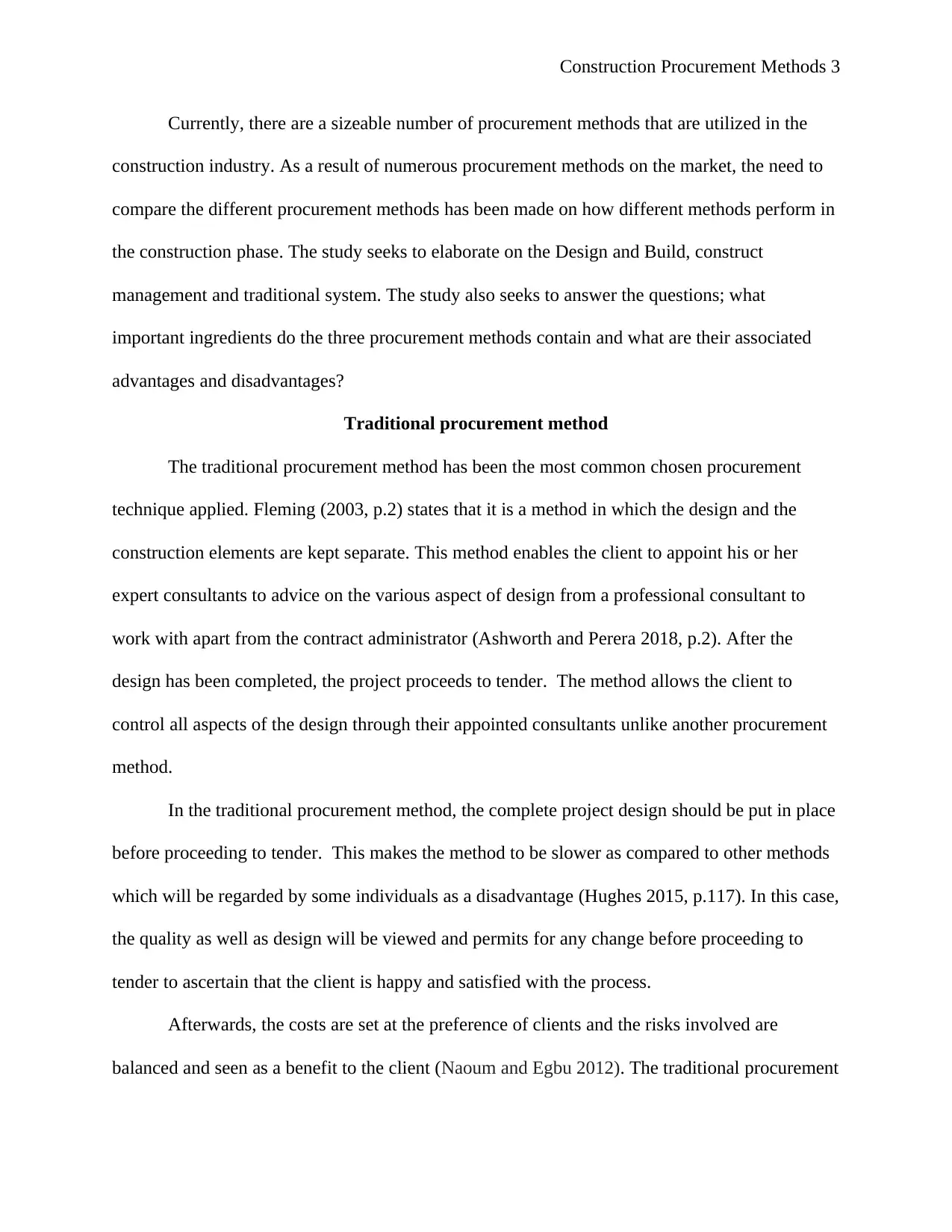
Construction Procurement Methods 3
Currently, there are a sizeable number of procurement methods that are utilized in the
construction industry. As a result of numerous procurement methods on the market, the need to
compare the different procurement methods has been made on how different methods perform in
the construction phase. The study seeks to elaborate on the Design and Build, construct
management and traditional system. The study also seeks to answer the questions; what
important ingredients do the three procurement methods contain and what are their associated
advantages and disadvantages?
Traditional procurement method
The traditional procurement method has been the most common chosen procurement
technique applied. Fleming (2003, p.2) states that it is a method in which the design and the
construction elements are kept separate. This method enables the client to appoint his or her
expert consultants to advice on the various aspect of design from a professional consultant to
work with apart from the contract administrator (Ashworth and Perera 2018, p.2). After the
design has been completed, the project proceeds to tender. The method allows the client to
control all aspects of the design through their appointed consultants unlike another procurement
method.
In the traditional procurement method, the complete project design should be put in place
before proceeding to tender. This makes the method to be slower as compared to other methods
which will be regarded by some individuals as a disadvantage (Hughes 2015, p.117). In this case,
the quality as well as design will be viewed and permits for any change before proceeding to
tender to ascertain that the client is happy and satisfied with the process.
Afterwards, the costs are set at the preference of clients and the risks involved are
balanced and seen as a benefit to the client (Naoum and Egbu 2012). The traditional procurement
Currently, there are a sizeable number of procurement methods that are utilized in the
construction industry. As a result of numerous procurement methods on the market, the need to
compare the different procurement methods has been made on how different methods perform in
the construction phase. The study seeks to elaborate on the Design and Build, construct
management and traditional system. The study also seeks to answer the questions; what
important ingredients do the three procurement methods contain and what are their associated
advantages and disadvantages?
Traditional procurement method
The traditional procurement method has been the most common chosen procurement
technique applied. Fleming (2003, p.2) states that it is a method in which the design and the
construction elements are kept separate. This method enables the client to appoint his or her
expert consultants to advice on the various aspect of design from a professional consultant to
work with apart from the contract administrator (Ashworth and Perera 2018, p.2). After the
design has been completed, the project proceeds to tender. The method allows the client to
control all aspects of the design through their appointed consultants unlike another procurement
method.
In the traditional procurement method, the complete project design should be put in place
before proceeding to tender. This makes the method to be slower as compared to other methods
which will be regarded by some individuals as a disadvantage (Hughes 2015, p.117). In this case,
the quality as well as design will be viewed and permits for any change before proceeding to
tender to ascertain that the client is happy and satisfied with the process.
Afterwards, the costs are set at the preference of clients and the risks involved are
balanced and seen as a benefit to the client (Naoum and Egbu 2012). The traditional procurement
⊘ This is a preview!⊘
Do you want full access?
Subscribe today to unlock all pages.

Trusted by 1+ million students worldwide
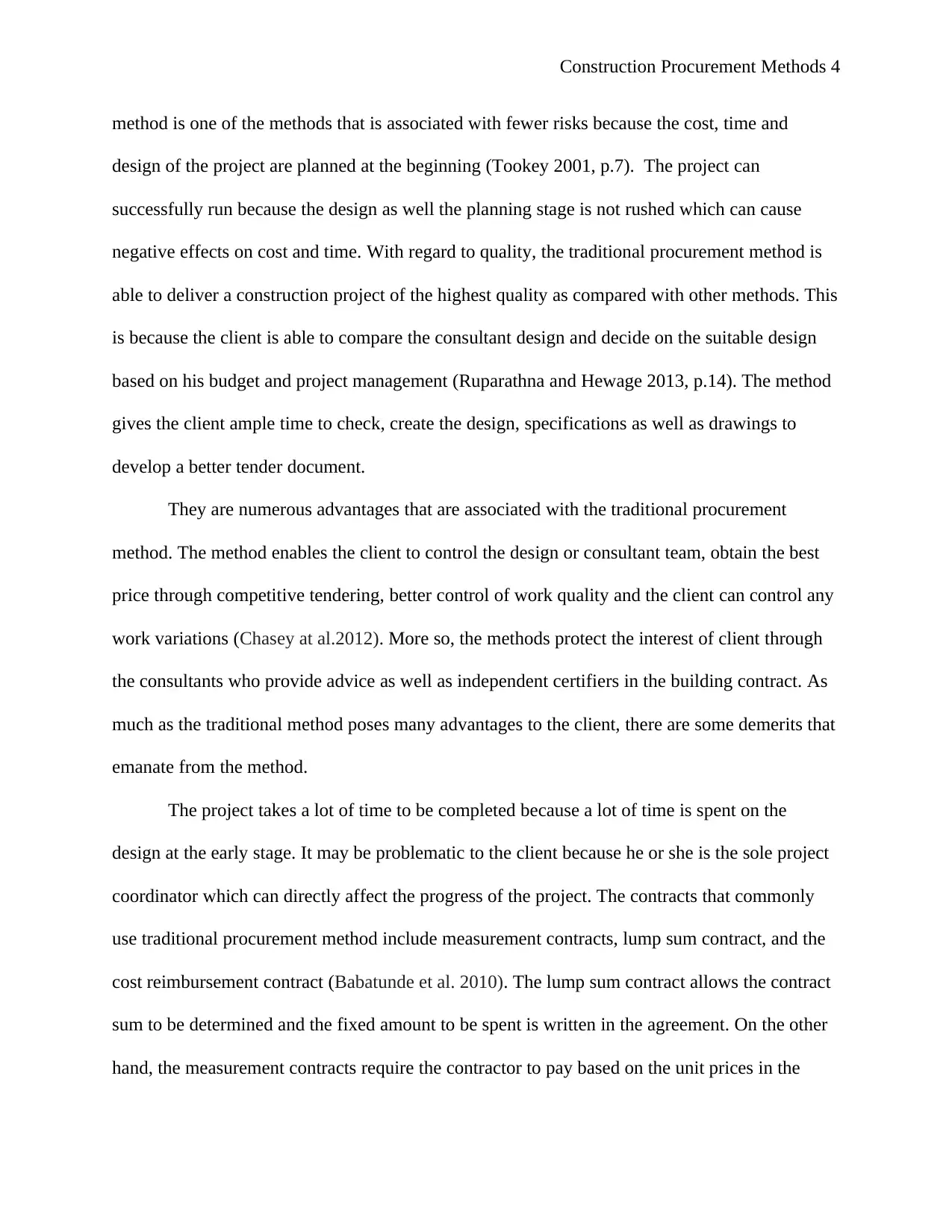
Construction Procurement Methods 4
method is one of the methods that is associated with fewer risks because the cost, time and
design of the project are planned at the beginning (Tookey 2001, p.7). The project can
successfully run because the design as well the planning stage is not rushed which can cause
negative effects on cost and time. With regard to quality, the traditional procurement method is
able to deliver a construction project of the highest quality as compared with other methods. This
is because the client is able to compare the consultant design and decide on the suitable design
based on his budget and project management (Ruparathna and Hewage 2013, p.14). The method
gives the client ample time to check, create the design, specifications as well as drawings to
develop a better tender document.
They are numerous advantages that are associated with the traditional procurement
method. The method enables the client to control the design or consultant team, obtain the best
price through competitive tendering, better control of work quality and the client can control any
work variations (Chasey at al.2012). More so, the methods protect the interest of client through
the consultants who provide advice as well as independent certifiers in the building contract. As
much as the traditional method poses many advantages to the client, there are some demerits that
emanate from the method.
The project takes a lot of time to be completed because a lot of time is spent on the
design at the early stage. It may be problematic to the client because he or she is the sole project
coordinator which can directly affect the progress of the project. The contracts that commonly
use traditional procurement method include measurement contracts, lump sum contract, and the
cost reimbursement contract (Babatunde et al. 2010). The lump sum contract allows the contract
sum to be determined and the fixed amount to be spent is written in the agreement. On the other
hand, the measurement contracts require the contractor to pay based on the unit prices in the
method is one of the methods that is associated with fewer risks because the cost, time and
design of the project are planned at the beginning (Tookey 2001, p.7). The project can
successfully run because the design as well the planning stage is not rushed which can cause
negative effects on cost and time. With regard to quality, the traditional procurement method is
able to deliver a construction project of the highest quality as compared with other methods. This
is because the client is able to compare the consultant design and decide on the suitable design
based on his budget and project management (Ruparathna and Hewage 2013, p.14). The method
gives the client ample time to check, create the design, specifications as well as drawings to
develop a better tender document.
They are numerous advantages that are associated with the traditional procurement
method. The method enables the client to control the design or consultant team, obtain the best
price through competitive tendering, better control of work quality and the client can control any
work variations (Chasey at al.2012). More so, the methods protect the interest of client through
the consultants who provide advice as well as independent certifiers in the building contract. As
much as the traditional method poses many advantages to the client, there are some demerits that
emanate from the method.
The project takes a lot of time to be completed because a lot of time is spent on the
design at the early stage. It may be problematic to the client because he or she is the sole project
coordinator which can directly affect the progress of the project. The contracts that commonly
use traditional procurement method include measurement contracts, lump sum contract, and the
cost reimbursement contract (Babatunde et al. 2010). The lump sum contract allows the contract
sum to be determined and the fixed amount to be spent is written in the agreement. On the other
hand, the measurement contracts require the contractor to pay based on the unit prices in the
Paraphrase This Document
Need a fresh take? Get an instant paraphrase of this document with our AI Paraphraser
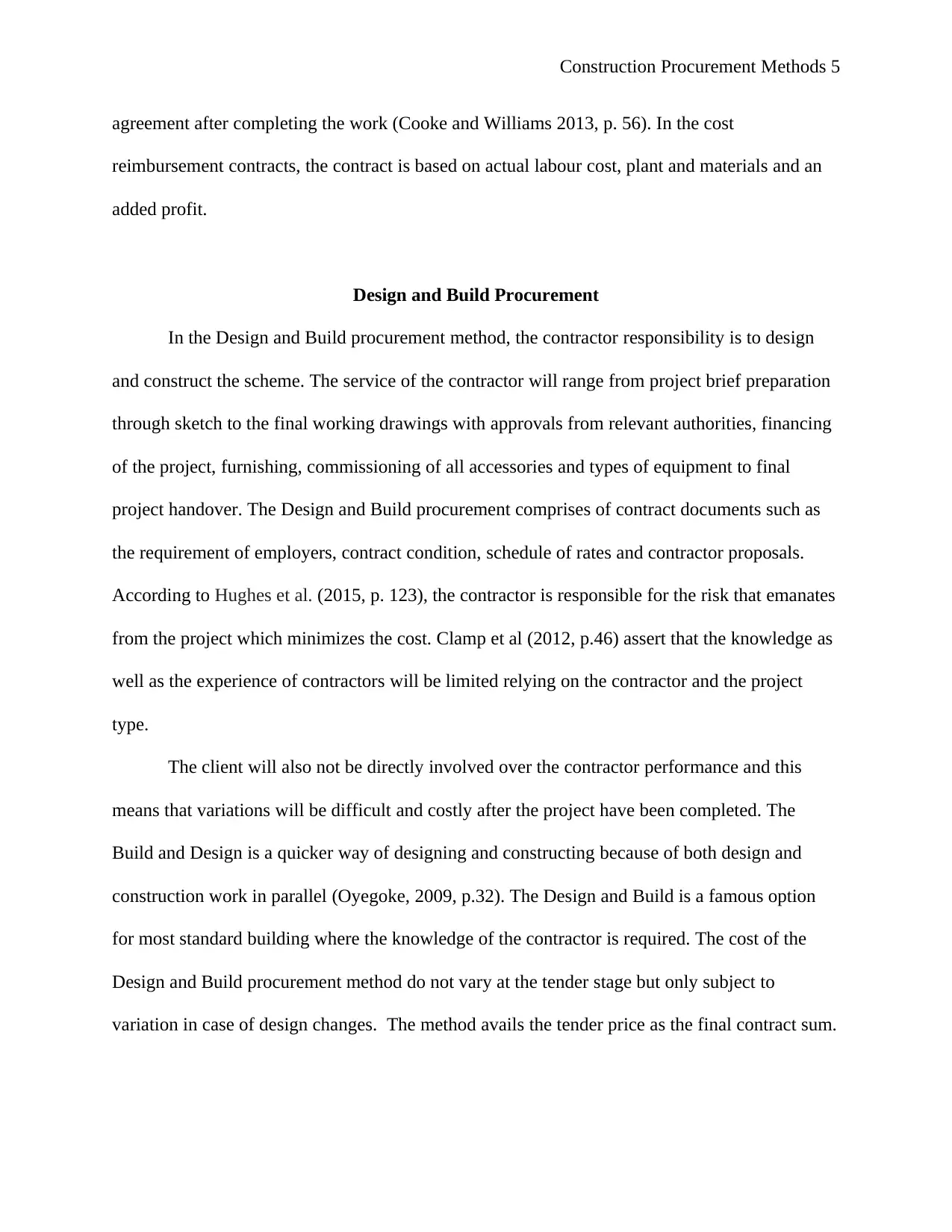
Construction Procurement Methods 5
agreement after completing the work (Cooke and Williams 2013, p. 56). In the cost
reimbursement contracts, the contract is based on actual labour cost, plant and materials and an
added profit.
Design and Build Procurement
In the Design and Build procurement method, the contractor responsibility is to design
and construct the scheme. The service of the contractor will range from project brief preparation
through sketch to the final working drawings with approvals from relevant authorities, financing
of the project, furnishing, commissioning of all accessories and types of equipment to final
project handover. The Design and Build procurement comprises of contract documents such as
the requirement of employers, contract condition, schedule of rates and contractor proposals.
According to Hughes et al. (2015, p. 123), the contractor is responsible for the risk that emanates
from the project which minimizes the cost. Clamp et al (2012, p.46) assert that the knowledge as
well as the experience of contractors will be limited relying on the contractor and the project
type.
The client will also not be directly involved over the contractor performance and this
means that variations will be difficult and costly after the project have been completed. The
Build and Design is a quicker way of designing and constructing because of both design and
construction work in parallel (Oyegoke, 2009, p.32). The Design and Build is a famous option
for most standard building where the knowledge of the contractor is required. The cost of the
Design and Build procurement method do not vary at the tender stage but only subject to
variation in case of design changes. The method avails the tender price as the final contract sum.
agreement after completing the work (Cooke and Williams 2013, p. 56). In the cost
reimbursement contracts, the contract is based on actual labour cost, plant and materials and an
added profit.
Design and Build Procurement
In the Design and Build procurement method, the contractor responsibility is to design
and construct the scheme. The service of the contractor will range from project brief preparation
through sketch to the final working drawings with approvals from relevant authorities, financing
of the project, furnishing, commissioning of all accessories and types of equipment to final
project handover. The Design and Build procurement comprises of contract documents such as
the requirement of employers, contract condition, schedule of rates and contractor proposals.
According to Hughes et al. (2015, p. 123), the contractor is responsible for the risk that emanates
from the project which minimizes the cost. Clamp et al (2012, p.46) assert that the knowledge as
well as the experience of contractors will be limited relying on the contractor and the project
type.
The client will also not be directly involved over the contractor performance and this
means that variations will be difficult and costly after the project have been completed. The
Build and Design is a quicker way of designing and constructing because of both design and
construction work in parallel (Oyegoke, 2009, p.32). The Design and Build is a famous option
for most standard building where the knowledge of the contractor is required. The cost of the
Design and Build procurement method do not vary at the tender stage but only subject to
variation in case of design changes. The method avails the tender price as the final contract sum.
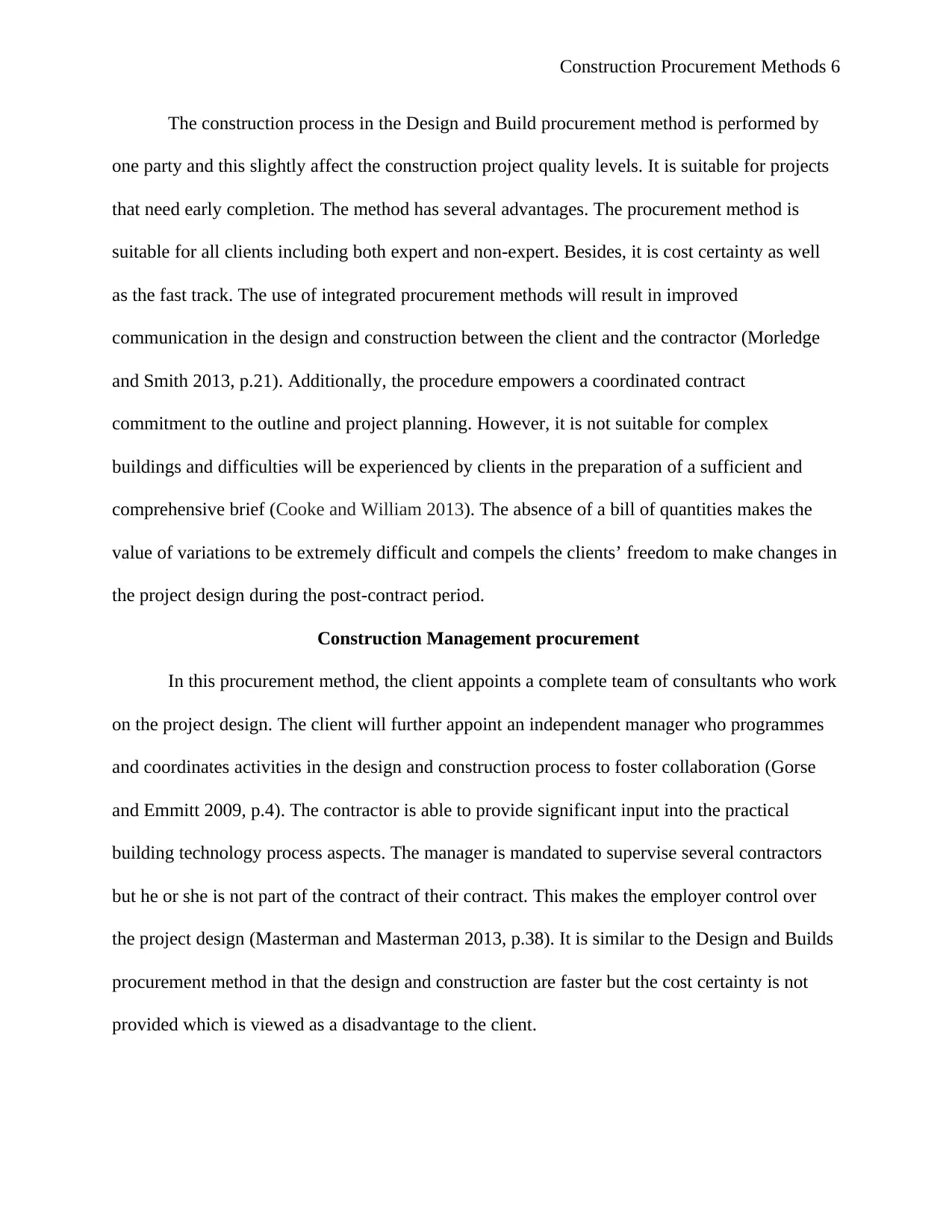
Construction Procurement Methods 6
The construction process in the Design and Build procurement method is performed by
one party and this slightly affect the construction project quality levels. It is suitable for projects
that need early completion. The method has several advantages. The procurement method is
suitable for all clients including both expert and non-expert. Besides, it is cost certainty as well
as the fast track. The use of integrated procurement methods will result in improved
communication in the design and construction between the client and the contractor (Morledge
and Smith 2013, p.21). Additionally, the procedure empowers a coordinated contract
commitment to the outline and project planning. However, it is not suitable for complex
buildings and difficulties will be experienced by clients in the preparation of a sufficient and
comprehensive brief (Cooke and William 2013). The absence of a bill of quantities makes the
value of variations to be extremely difficult and compels the clients’ freedom to make changes in
the project design during the post-contract period.
Construction Management procurement
In this procurement method, the client appoints a complete team of consultants who work
on the project design. The client will further appoint an independent manager who programmes
and coordinates activities in the design and construction process to foster collaboration (Gorse
and Emmitt 2009, p.4). The contractor is able to provide significant input into the practical
building technology process aspects. The manager is mandated to supervise several contractors
but he or she is not part of the contract of their contract. This makes the employer control over
the project design (Masterman and Masterman 2013, p.38). It is similar to the Design and Builds
procurement method in that the design and construction are faster but the cost certainty is not
provided which is viewed as a disadvantage to the client.
The construction process in the Design and Build procurement method is performed by
one party and this slightly affect the construction project quality levels. It is suitable for projects
that need early completion. The method has several advantages. The procurement method is
suitable for all clients including both expert and non-expert. Besides, it is cost certainty as well
as the fast track. The use of integrated procurement methods will result in improved
communication in the design and construction between the client and the contractor (Morledge
and Smith 2013, p.21). Additionally, the procedure empowers a coordinated contract
commitment to the outline and project planning. However, it is not suitable for complex
buildings and difficulties will be experienced by clients in the preparation of a sufficient and
comprehensive brief (Cooke and William 2013). The absence of a bill of quantities makes the
value of variations to be extremely difficult and compels the clients’ freedom to make changes in
the project design during the post-contract period.
Construction Management procurement
In this procurement method, the client appoints a complete team of consultants who work
on the project design. The client will further appoint an independent manager who programmes
and coordinates activities in the design and construction process to foster collaboration (Gorse
and Emmitt 2009, p.4). The contractor is able to provide significant input into the practical
building technology process aspects. The manager is mandated to supervise several contractors
but he or she is not part of the contract of their contract. This makes the employer control over
the project design (Masterman and Masterman 2013, p.38). It is similar to the Design and Builds
procurement method in that the design and construction are faster but the cost certainty is not
provided which is viewed as a disadvantage to the client.
⊘ This is a preview!⊘
Do you want full access?
Subscribe today to unlock all pages.

Trusted by 1+ million students worldwide
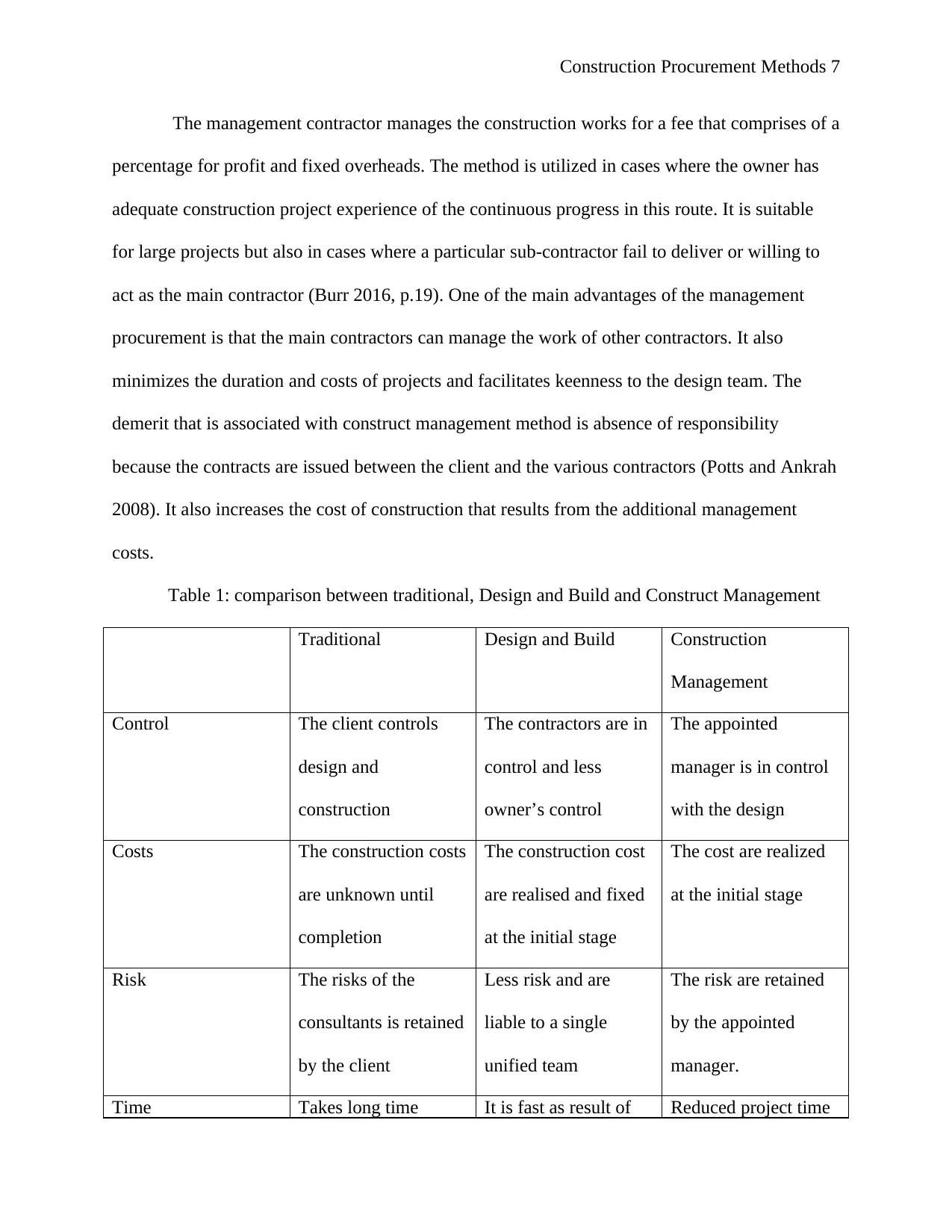
Construction Procurement Methods 7
The management contractor manages the construction works for a fee that comprises of a
percentage for profit and fixed overheads. The method is utilized in cases where the owner has
adequate construction project experience of the continuous progress in this route. It is suitable
for large projects but also in cases where a particular sub-contractor fail to deliver or willing to
act as the main contractor (Burr 2016, p.19). One of the main advantages of the management
procurement is that the main contractors can manage the work of other contractors. It also
minimizes the duration and costs of projects and facilitates keenness to the design team. The
demerit that is associated with construct management method is absence of responsibility
because the contracts are issued between the client and the various contractors (Potts and Ankrah
2008). It also increases the cost of construction that results from the additional management
costs.
Table 1: comparison between traditional, Design and Build and Construct Management
Traditional Design and Build Construction
Management
Control The client controls
design and
construction
The contractors are in
control and less
owner’s control
The appointed
manager is in control
with the design
Costs The construction costs
are unknown until
completion
The construction cost
are realised and fixed
at the initial stage
The cost are realized
at the initial stage
Risk The risks of the
consultants is retained
by the client
Less risk and are
liable to a single
unified team
The risk are retained
by the appointed
manager.
Time Takes long time It is fast as result of Reduced project time
The management contractor manages the construction works for a fee that comprises of a
percentage for profit and fixed overheads. The method is utilized in cases where the owner has
adequate construction project experience of the continuous progress in this route. It is suitable
for large projects but also in cases where a particular sub-contractor fail to deliver or willing to
act as the main contractor (Burr 2016, p.19). One of the main advantages of the management
procurement is that the main contractors can manage the work of other contractors. It also
minimizes the duration and costs of projects and facilitates keenness to the design team. The
demerit that is associated with construct management method is absence of responsibility
because the contracts are issued between the client and the various contractors (Potts and Ankrah
2008). It also increases the cost of construction that results from the additional management
costs.
Table 1: comparison between traditional, Design and Build and Construct Management
Traditional Design and Build Construction
Management
Control The client controls
design and
construction
The contractors are in
control and less
owner’s control
The appointed
manager is in control
with the design
Costs The construction costs
are unknown until
completion
The construction cost
are realised and fixed
at the initial stage
The cost are realized
at the initial stage
Risk The risks of the
consultants is retained
by the client
Less risk and are
liable to a single
unified team
The risk are retained
by the appointed
manager.
Time Takes long time It is fast as result of Reduced project time
Paraphrase This Document
Need a fresh take? Get an instant paraphrase of this document with our AI Paraphraser
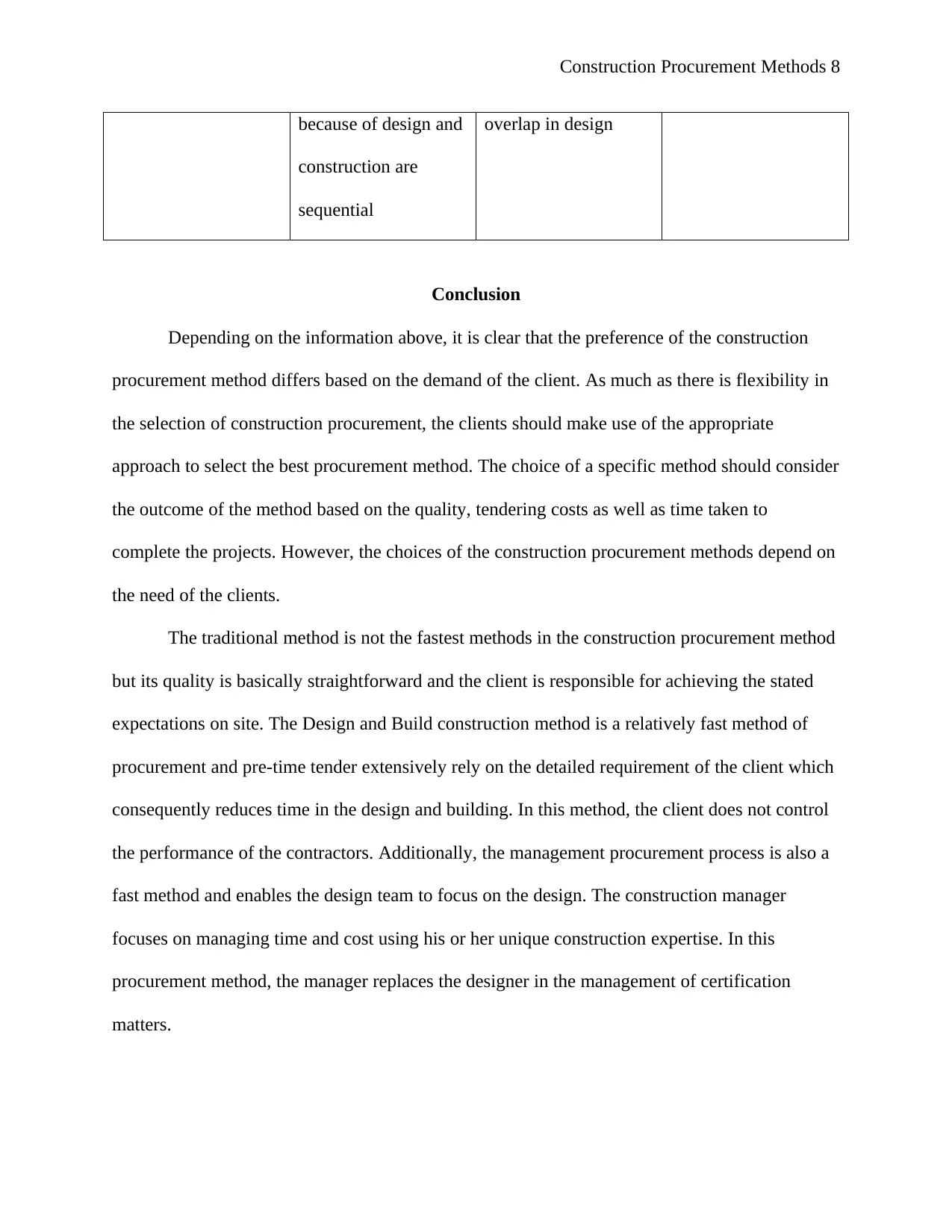
Construction Procurement Methods 8
because of design and
construction are
sequential
overlap in design
Conclusion
Depending on the information above, it is clear that the preference of the construction
procurement method differs based on the demand of the client. As much as there is flexibility in
the selection of construction procurement, the clients should make use of the appropriate
approach to select the best procurement method. The choice of a specific method should consider
the outcome of the method based on the quality, tendering costs as well as time taken to
complete the projects. However, the choices of the construction procurement methods depend on
the need of the clients.
The traditional method is not the fastest methods in the construction procurement method
but its quality is basically straightforward and the client is responsible for achieving the stated
expectations on site. The Design and Build construction method is a relatively fast method of
procurement and pre-time tender extensively rely on the detailed requirement of the client which
consequently reduces time in the design and building. In this method, the client does not control
the performance of the contractors. Additionally, the management procurement process is also a
fast method and enables the design team to focus on the design. The construction manager
focuses on managing time and cost using his or her unique construction expertise. In this
procurement method, the manager replaces the designer in the management of certification
matters.
because of design and
construction are
sequential
overlap in design
Conclusion
Depending on the information above, it is clear that the preference of the construction
procurement method differs based on the demand of the client. As much as there is flexibility in
the selection of construction procurement, the clients should make use of the appropriate
approach to select the best procurement method. The choice of a specific method should consider
the outcome of the method based on the quality, tendering costs as well as time taken to
complete the projects. However, the choices of the construction procurement methods depend on
the need of the clients.
The traditional method is not the fastest methods in the construction procurement method
but its quality is basically straightforward and the client is responsible for achieving the stated
expectations on site. The Design and Build construction method is a relatively fast method of
procurement and pre-time tender extensively rely on the detailed requirement of the client which
consequently reduces time in the design and building. In this method, the client does not control
the performance of the contractors. Additionally, the management procurement process is also a
fast method and enables the design team to focus on the design. The construction manager
focuses on managing time and cost using his or her unique construction expertise. In this
procurement method, the manager replaces the designer in the management of certification
matters.
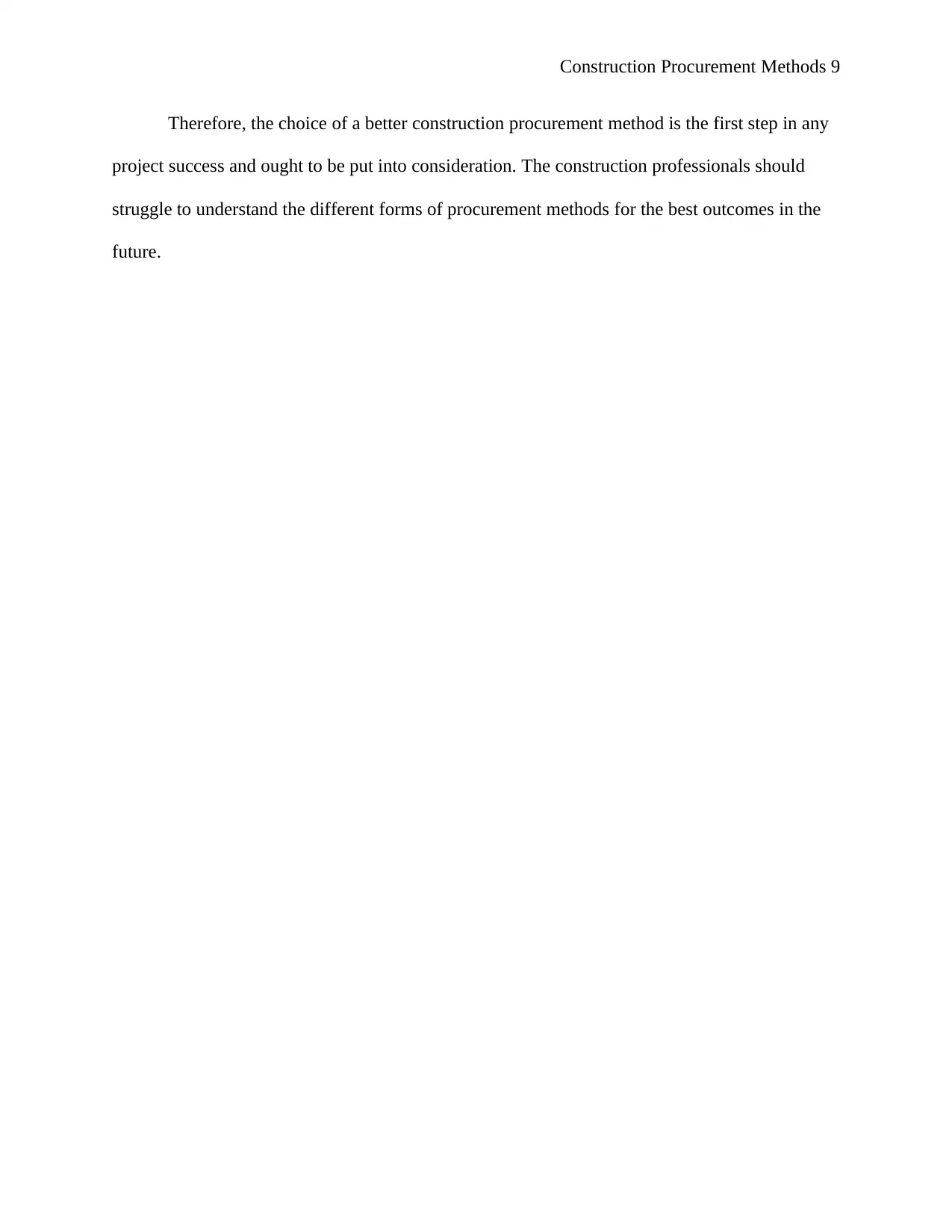
Construction Procurement Methods 9
Therefore, the choice of a better construction procurement method is the first step in any
project success and ought to be put into consideration. The construction professionals should
struggle to understand the different forms of procurement methods for the best outcomes in the
future.
Therefore, the choice of a better construction procurement method is the first step in any
project success and ought to be put into consideration. The construction professionals should
struggle to understand the different forms of procurement methods for the best outcomes in the
future.
⊘ This is a preview!⊘
Do you want full access?
Subscribe today to unlock all pages.

Trusted by 1+ million students worldwide
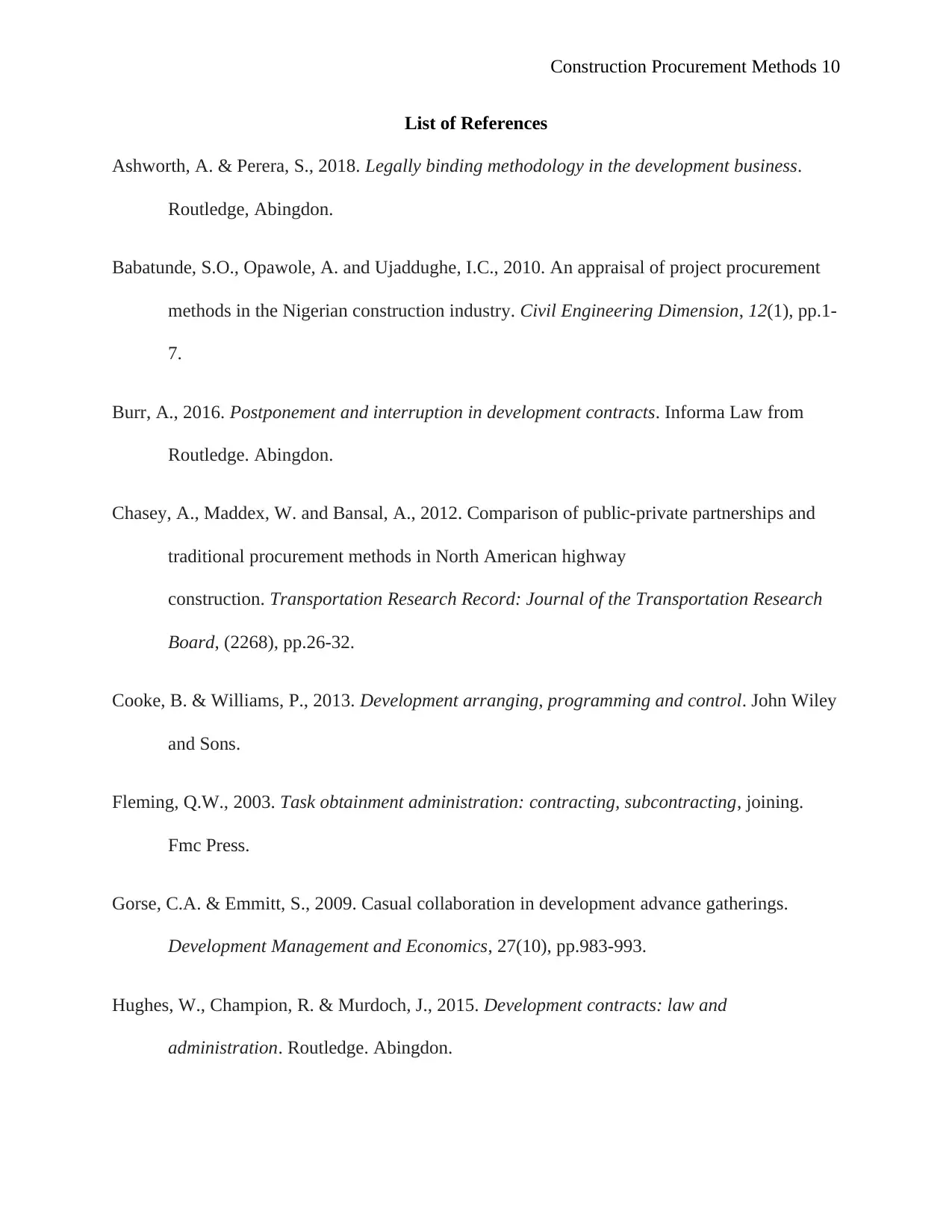
Construction Procurement Methods 10
List of References
Ashworth, A. & Perera, S., 2018. Legally binding methodology in the development business.
Routledge, Abingdon.
Babatunde, S.O., Opawole, A. and Ujaddughe, I.C., 2010. An appraisal of project procurement
methods in the Nigerian construction industry. Civil Engineering Dimension, 12(1), pp.1-
7.
Burr, A., 2016. Postponement and interruption in development contracts. Informa Law from
Routledge. Abingdon.
Chasey, A., Maddex, W. and Bansal, A., 2012. Comparison of public-private partnerships and
traditional procurement methods in North American highway
construction. Transportation Research Record: Journal of the Transportation Research
Board, (2268), pp.26-32.
Cooke, B. & Williams, P., 2013. Development arranging, programming and control. John Wiley
and Sons.
Fleming, Q.W., 2003. Task obtainment administration: contracting, subcontracting, joining.
Fmc Press.
Gorse, C.A. & Emmitt, S., 2009. Casual collaboration in development advance gatherings.
Development Management and Economics, 27(10), pp.983-993.
Hughes, W., Champion, R. & Murdoch, J., 2015. Development contracts: law and
administration. Routledge. Abingdon.
List of References
Ashworth, A. & Perera, S., 2018. Legally binding methodology in the development business.
Routledge, Abingdon.
Babatunde, S.O., Opawole, A. and Ujaddughe, I.C., 2010. An appraisal of project procurement
methods in the Nigerian construction industry. Civil Engineering Dimension, 12(1), pp.1-
7.
Burr, A., 2016. Postponement and interruption in development contracts. Informa Law from
Routledge. Abingdon.
Chasey, A., Maddex, W. and Bansal, A., 2012. Comparison of public-private partnerships and
traditional procurement methods in North American highway
construction. Transportation Research Record: Journal of the Transportation Research
Board, (2268), pp.26-32.
Cooke, B. & Williams, P., 2013. Development arranging, programming and control. John Wiley
and Sons.
Fleming, Q.W., 2003. Task obtainment administration: contracting, subcontracting, joining.
Fmc Press.
Gorse, C.A. & Emmitt, S., 2009. Casual collaboration in development advance gatherings.
Development Management and Economics, 27(10), pp.983-993.
Hughes, W., Champion, R. & Murdoch, J., 2015. Development contracts: law and
administration. Routledge. Abingdon.
Paraphrase This Document
Need a fresh take? Get an instant paraphrase of this document with our AI Paraphraser
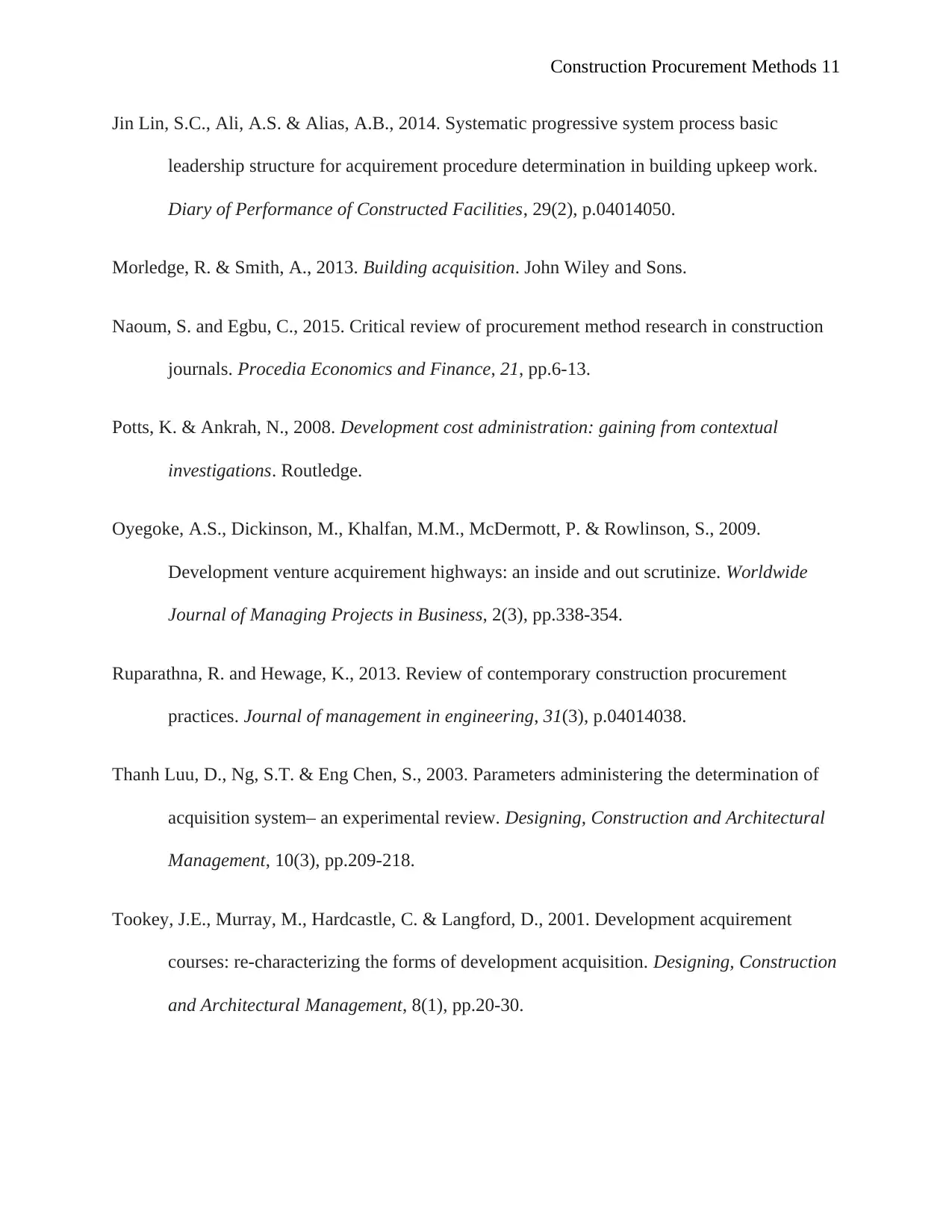
Construction Procurement Methods 11
Jin Lin, S.C., Ali, A.S. & Alias, A.B., 2014. Systematic progressive system process basic
leadership structure for acquirement procedure determination in building upkeep work.
Diary of Performance of Constructed Facilities, 29(2), p.04014050.
Morledge, R. & Smith, A., 2013. Building acquisition. John Wiley and Sons.
Naoum, S. and Egbu, C., 2015. Critical review of procurement method research in construction
journals. Procedia Economics and Finance, 21, pp.6-13.
Potts, K. & Ankrah, N., 2008. Development cost administration: gaining from contextual
investigations. Routledge.
Oyegoke, A.S., Dickinson, M., Khalfan, M.M., McDermott, P. & Rowlinson, S., 2009.
Development venture acquirement highways: an inside and out scrutinize. Worldwide
Journal of Managing Projects in Business, 2(3), pp.338-354.
Ruparathna, R. and Hewage, K., 2013. Review of contemporary construction procurement
practices. Journal of management in engineering, 31(3), p.04014038.
Thanh Luu, D., Ng, S.T. & Eng Chen, S., 2003. Parameters administering the determination of
acquisition system– an experimental review. Designing, Construction and Architectural
Management, 10(3), pp.209-218.
Tookey, J.E., Murray, M., Hardcastle, C. & Langford, D., 2001. Development acquirement
courses: re-characterizing the forms of development acquisition. Designing, Construction
and Architectural Management, 8(1), pp.20-30.
Jin Lin, S.C., Ali, A.S. & Alias, A.B., 2014. Systematic progressive system process basic
leadership structure for acquirement procedure determination in building upkeep work.
Diary of Performance of Constructed Facilities, 29(2), p.04014050.
Morledge, R. & Smith, A., 2013. Building acquisition. John Wiley and Sons.
Naoum, S. and Egbu, C., 2015. Critical review of procurement method research in construction
journals. Procedia Economics and Finance, 21, pp.6-13.
Potts, K. & Ankrah, N., 2008. Development cost administration: gaining from contextual
investigations. Routledge.
Oyegoke, A.S., Dickinson, M., Khalfan, M.M., McDermott, P. & Rowlinson, S., 2009.
Development venture acquirement highways: an inside and out scrutinize. Worldwide
Journal of Managing Projects in Business, 2(3), pp.338-354.
Ruparathna, R. and Hewage, K., 2013. Review of contemporary construction procurement
practices. Journal of management in engineering, 31(3), p.04014038.
Thanh Luu, D., Ng, S.T. & Eng Chen, S., 2003. Parameters administering the determination of
acquisition system– an experimental review. Designing, Construction and Architectural
Management, 10(3), pp.209-218.
Tookey, J.E., Murray, M., Hardcastle, C. & Langford, D., 2001. Development acquirement
courses: re-characterizing the forms of development acquisition. Designing, Construction
and Architectural Management, 8(1), pp.20-30.
1 out of 11
Related Documents
Your All-in-One AI-Powered Toolkit for Academic Success.
+13062052269
info@desklib.com
Available 24*7 on WhatsApp / Email
![[object Object]](/_next/static/media/star-bottom.7253800d.svg)
Unlock your academic potential
Copyright © 2020–2025 A2Z Services. All Rights Reserved. Developed and managed by ZUCOL.





